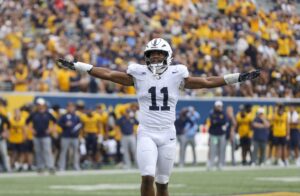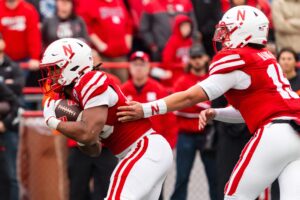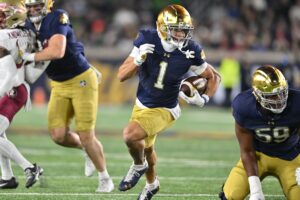Part one of our look at the UCLA-USC rivalry gave the flavor of a collision that is built around proximity, with the two being only 13 miles apart from each other. The two schools spend 365 days a year recruiting against each other for the same area high school players. When it comes to the recruits/players, high school teammates become bitter rivals. High school rivals become bonded college teammates. Sometimes families are fractured.
UCLA vs. USC; Know The Rivalry
One Family, Two Directions

Wendell Tyler was a prodigious running back for the Bruins in the mid-1970’s, and a star of the 1976 Rose Bowl championship team. He was always held in high regard on the UCLA campus, even as his Los Angeles Rams and San Francisco 49ers careers ended, and he went into quiet obscurity.

That is until his son Marc Tyler signed with USC in 2007. Marc’s college career was pedestrian at best, but his dad was getting hate mail, according to an interview the pair did with the Sporting News prior to Marc’s graduation. How dare the son of a Bruin legend go to the wrong side of the tracks. That is not ok when it is USC vs. UCLA.
Trojans Dominate Early and Often
The years have seen it all in this rivalry. USC, with a nearly four decades headstart as a university and athletic department, dominated UCLA from their first game in 1929 up through 1945. The Trojans went 10-1-4 against UCLA in those early years, under coach Howard Jones. He remains a legend at USC, with the practice facilities named after him. The Trojans won four national championships in the Jones era.
The Bruins finally started showing up in the 1950’s with Henry “Red” Sanders coaching. They went 7-2-1 against USC and won the only football national championship to this day in Westwood, in 1954.

USC owned the 1960’s in the rivalry, going 7-3 against UCLA. This, however, was the decade when the stars started to shine brightly on both sides. Names like Billy Kilmer, Kermit Alexander, and Gary Beban (UCLA’s only Heisman winner), were going up against the likes of O.J. Simpson and Mike Garrett for USC. Both were Heisman winners and Garrett would go on to become USC’s athletic director in some its most successful, and troubled, times.
A Classic For The Ages
The 1967 UCLA vs. USC football game remains regarded as one of the highlight games of college football lore. The Bruins were 7–0–1 and ranked #1 in the country, with senior quarterback Beban as a Heisman Trophy candidate. The Trojans were 8–1 and ranked #4, with Simpson as their Heisman candidate. USC won the game 21-20 when Simpson scampered for a 64-yard touchdown run in the fourth quarter that is still on highlight reels to this day. Beban’s consolation prize was the Heisman.
Times Change
USC coach John McKay was building a juggernaut in South Los Angeles. In the early 1970’s, despite the glamour of quarterback Mark Harmon (of current CSI fame), UCLA could not keep up with the likes of Sam Cunningham, Pat Haden, Lynn Swan, Anthony Davis, and Trojan defenses that would send five to six players to the NFL each year.

Both teams had coaching changes after the 1975 season. McKay left for the new Tampa Bay Buccaneers franchise in the NFL. He was replaced by Oakland Raiders assistant John Robinson. UCLA was coming off a Rose Bowl win over Archie Griffin and #1 Ohio State. UCLA head coach Dick Vermeil left to take over the Philadelphia Eagles. The Bruins stayed in-house with assistant coach Terry Donahue. It went decidedly better for one side than the other. How serious is this match-up? UCLA lost the first four of the Donahue era to USC. Donahue openly acknowledges that if they lost the fifth in a row in 1980, he expected to be fired. The Bruins won 20-17.
Trojans Twist; UCLA Creates A Legend
Robinson left USC after the 1983 season to take over the Los Angeles Rams. The dark days at USC were wide open. Over the next 17 years, the Trojans would employ the likes of Ted Tollner, Larry Smith, and Paul Hackett. They even went back to a second tenure of a then washed-out Robinson. On the other side of town, Donahue not only avoided that firing but lasted until his retirement in 1995. He became the winningest coach in conference history and is now in the CFB hall of fame. And as most coaches in this rivalry do, Donahue had “that game of games to remember.”

Typical of the series, even the mundane often turns to magic. In 1992, thanks to injuries UCLA was on its fourth-string quarterback going into the USC game. John Barnes was a walk-on who was on his fourth college. He played at a junior college, an NAIA school and a Division III program that dropped football after he got there. All he did in his one shot in the bright lights was engineer one of the most improbable moments in the history of the UCLA-USC rivalry, directing a 21-point fourth quarter rally that gave the Bruins a 38-37 victory. His football career may not have lived up to his dreams, but to Bruin fans, he is a forever legend.
Even with all the coaching turnover in Trojan-land, UCLA only managed to get a 5-4-1 edge in the 80’s decade of the rivalry. Upon Donahue’s retirement in 1995, UCLA went to offensive coordinator Bob Toledo. The first three years of the Toledo era, combined with the last five of the Donahue regime, gave UCLA an eight-game winning streak in the series, the longest such to this day. Toledo, though, was living under NCAA clouds and was fired in 2002.
The Fifth Choice Is The Charm

The tide turned far in the other direction when in 2001 USC AD Mike Garrett got his fifth choice to replace the fired Hackett. Pete Carroll came to USC and quickly dominated the rivalry. The likes of Bush, Leinart, and Sanchez were winning conference championships and competing for national titles on a yearly basis. They lost to UCLA only once during the 2001-2009 Carroll era. But what a loss it was.
In the true romance of this rivalry, in 2006, the #2 ranked Trojans were one win against UCLA from advancing to the BCS title game. UCLA was a mediocre 6-6 in what was the middle of an equally mediocre coaching tenure for former Bruins wide receiver Karl Dorell. In the closing minute of the game, UCLA linebacker Eric McNeal tipped a John David Booty pass to himself for a stunning, diving interception. The Bruins would win 13-9, and just as important to them, they spoiled USC’s title run.
Dorrell would not last long, nor would his successor, Rick Neuheisel. Ironically Neuheisel was a UCLA quarterback under Donahue, and his favorite receiver was Dorrell.
The Here And Now; Where Legends Are Built
UCLA would hire Jim Mora who began his Westwood tenure while USC was making the cycle through Lane Kiffin to Ed Orgeron to Clay Helton to Steve Sarkisian and back to Helton. Mora won his first three games in the rivalry. But the Bruins have gotten hammered the last two years and are heavy underdogs this weekend at the Coliseum. As you can imagine, now knowing the history of this series, Mora’s job is believed to be in jeopardy. Even with other losses, if you win this game, you are granted a great deal of leniency in your coaching tenure.
When thinking about the legacies left behind in this rivalry consider this; Troy Aikman is in the college football hall fame. He is in the NFL hall of fame. In 2016, UCLA finally got around to retiring his number. He is a great with an asterisk by his name. He was 0-2 in classic match-ups against USC and quarterback Rodney Peete, (who allegedly played the 1988 game with measles). Cade McNown had a reputation as a scoundrel and was a washout in the NFL. Yet, he lives in Bruin lore because he was 4-0 against the Trojans from 1995-1998.
What you do throughout your career is one thing. What you do against the Bruins or the Trojans in your years in the rivalry is everything. “UCLA versus USC is not life and death. It is much more important than that.” -Red Sanders
Main Photo Credit:







